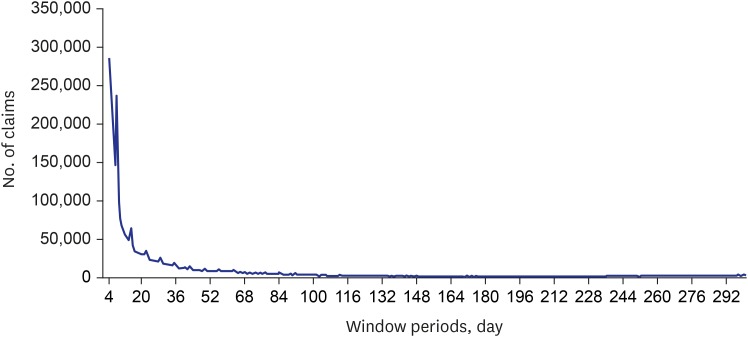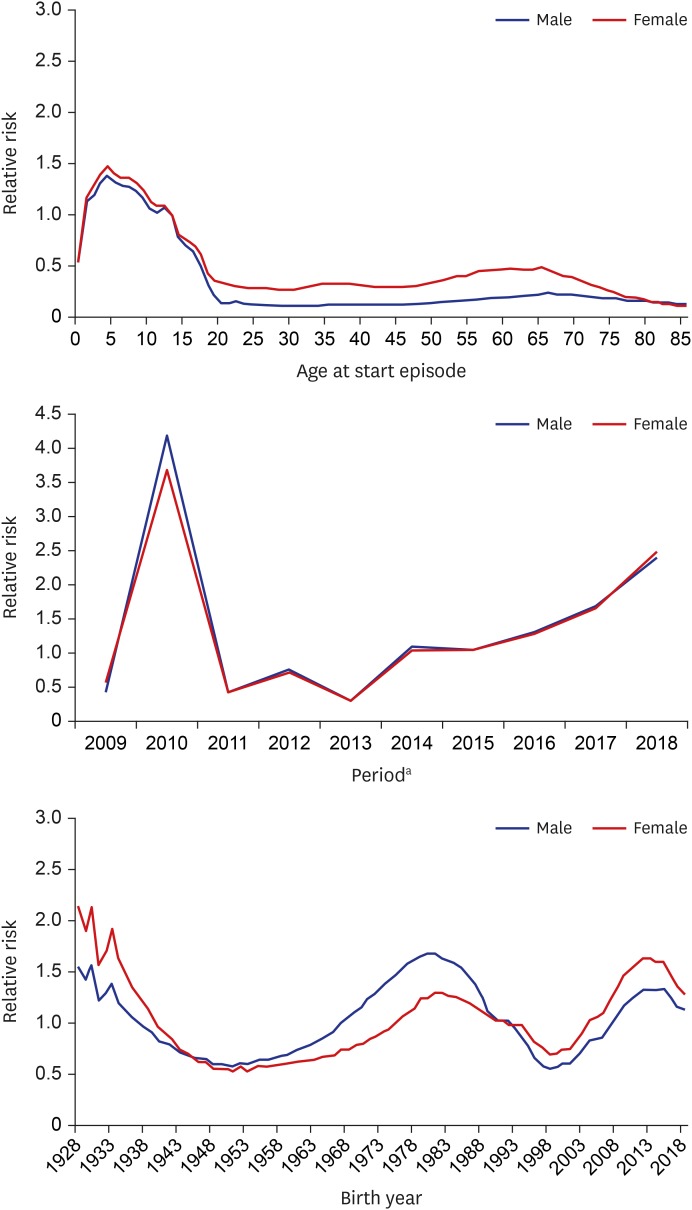J Korean Med Sci.
2020 Apr;35(18):e121. 10.3346/jkms.2020.35.e121.
Age-Period-Cohort Analysis of Influenza in Koreans: the National Health Insurance Research Database, 2009–2018
- Affiliations
-
- 1Department of Preventive Medicine, Hanyang University College of Medicine, Seoul, Korea
- 2Department of Public Health, Graduate School, Hanyang University, Seoul, Korea
- 3Institute of Genomic Cohort, Yonsei University Wonju College of Medicine, Wonju, Korea
- 4Division of Infectious Diseases, Department of Internal Medicine, Incheon Medical Center, Incheon, Korea
- KMID: 2500217
- DOI: http://doi.org/10.3346/jkms.2020.35.e121
Abstract
- Background
This study aimed to identify the incidence rate of episodes diagnosed with influenza and the effects of age-period-cohort (APC) in Koreans.
Methods
The 2009–2018 National Health Insurance Research Database was used for analysis. All time-related claims connected relatively short window period in 100 days. The case definition was defined by all codes diagnosed with J09, J10, and J11. Calculation of the incidence rate and APC analysis adjusted income levels by insurance type, metropolitan city was performed to identify the characteristics of episodes diagnosed with influenza.
Results
Incidence rate by age and cohort gradually increased since 2014. The incidence rate of males aged 0–4 years was 171.02 and that of females was 173.31 in 2015–2016 season. In males, 29.19 in 1963 cohort and 243.79 in 2013 cohort were confirmed as high incidence rates in 2017–2018 season. In the females, a high incidence was confirmed in 1953–1967 cohort and 1978–1987 cohort, and the incidence was 251.38 in 2013–2017 cohort. APC effects showed a high relative risk in the infants, the pandemic influenza season in 2010 (1/7/2009 to 30/6/2010) and the adults of 1978–1987 cohort.
Conclusion
Since 2014, influenza outbreaks have been increasing every year. The start year of free vaccination decreased the incidence in infants and adults over 65 years of age but the incidence increased from the following year. Because influenza can be primarily prevented by vaccination, reinforcement of vaccination in infants may reduce the disease burden in their parents, and also the risk of infection caused by family transmission. A new vaccination strategy is needed to reduce the incidence and burden of diseases caused by influenza infection.
Figure
Reference
-
1. Baek JH, Seo YB, Choi WS, Kee SY, Jeong HW, Lee HY, et al. Guideline on the prevention and control of seasonal influenza in healthcare setting. Korean J Intern Med. 2014; 29(2):265–280. PMID: 24648817.
Article2. Korea Centers for Disease Control and Prevention. Infectious disease portal. Updated 2019. Accessed May 10, 2019. http://www.cdc.go.kr/npt/.3. Korea Centers for Disease Control and Prevention. 2017–2018 Seasonal influenza national immunization program support project management guidelines for medical institutes. Updated 2017. Accessed Dec 15, 2017. http://www.cdc.go.kr/CDC/notice/CdcKrTogether0302.jsp?menuIds=HOME001-MNU1154-MNU0005-MNU0088&cid=75943.4. Korea Centers for Disease Control and Prevention. National immunization program. Updated 2019. Accessed May 10, 2019. https://nip.cdc.go.kr/irgd/index.html.5. Park SC, Cheong HJ, Sohn JW, Choi SJ, Eom JS, Woo HJ, et al. Efficacy of influenza vaccination among chronic Ill patients: retrospective case control study. Infect Chemother. 2004; 36(4):207–212.6. Heo JY, Song JY, Noh JY, Choi MJ, Yoon JG, Lee SN, et al. Effects of influenza immunization on pneumonia in the elderly. Hum Vaccin Immunother. 2018; 14(3):744–749. PMID: 29135343.
Article7. Choi WS, Lee J, Lee HY, Baek JH, Kim YK, Kee SY, et al. Clinical practice guideline for antiviral treatment and chemoprophylaxis of seasonal influenza. Infect Chemother. 2012; 44(4):233–249.
Article8. National Health Insurance Sharing Service. NHISS portal. Updated 2019. Accessed May 10, 2019. https://nhiss.nhis.or.kr/bd/ay/bdaya001iv.do.9. Health Insurance Review & Assessment Service. Healthcare bigdata hub. Updated 2018. Accessed Jan 9, 2018. http://opendata.hira.or.kr/op/opc/olap3thDsInfo.do.10. Kim JY, Im JH, Kim HY. Development of Risk Adjustment and Prediction Methods for Care Episodes Using National Health Insurance Database. Seoul: Health Insurance Review & Assessment Service;2007.11. Yang Y, Land KC. Age-Period-Cohort Analysis: New Models, Methods, and Empirical Applications. Boca Raton, FL: CRC press;2016.12. Lee HY, Yu JH, Hong JI. Elderly immunization program against influenza in Korea, 2015. Updated 2016. Accessed May 12, 2018. http://www.cdc.go.kr/CDC/info/CdcKrInfo0301.jsp?menuIds=HOME001-MNU1154-MNU0005-MNU0037-MNU1380&cid=67630.13. Korea Centers for Disease Control and Prevention. KCDC portal. Updated 2019. Accessed May 10, 2019. http://www.cdc.go.kr/CDC/main.jsp.14. Kamigaki T, Mimura S, Takahashi Y, Oshitani H. Analysis of influenza transmission in the households of primary and junior high school students during the 2012–13 influenza season in Odate, Japan. BMC Infect Dis. 2015; 15(1):282. PMID: 26201316.
Article15. Viboud C, Boëlle PY, Cauchemez S, Lavenu A, Valleron AJ, Flahault A, et al. Risk factors of influenza transmission in households. Br J Gen Pract. 2004; 54(506):684–689. PMID: 15353055.
Article16. Petrie JG, Ohmit SE, Cowling BJ, Johnson E, Cross RT, Malosh RE, et al. Influenza transmission in a cohort of households with children: 2010–2011. PLoS One. 2013; 8(9):e75339. PMID: 24086511.
Article17. Mossong J, Hens N, Jit M, Beutels P, Auranen K, Mikolajczyk R, et al. Social contacts and mixing patterns relevant to the spread of infectious diseases. PLoS Med. 2008; 5(3):e74. PMID: 18366252.
Article18. Kim JI, Park MS. An universal approach to getting ahead for influenza B vaccines. J Bacteriol Virol. 2012; 42(4):363–367.
Article
- Full Text Links
- Actions
-
Cited
- CITED
-
- Close
- Share
- Similar articles
-
- Introducing big data analysis using data from National Health Insurance Service
- Analysis of the incidence of dementia in complete edentulous patients using the National Health Insurance Service-Elderly Cohort Database (NHIS-ECD)
- Lessons Learnt from (HIN1)2009 Influenza Pandemic for Preparedness Against Future Pandemics
- Factors Affecting the Incidence of Hospitalized Pneumonia after Influenza Infection in Korea Using the National Health Insurance Research Database, 2014–2018: Focusing on the Effect of Antiviral Therapy in the 2017 Flu Season
- Data profile: the Korean Workers’ Compensation-National Health Insurance Service (KoWorC-NHIS) cohort



